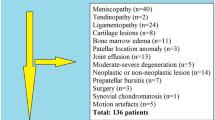Abstract
The radiological methods to determine patellar height described in the literature are variable, not reliable and depend on the chosen ratio. The purpose of this paper is to describe another method of measuring patellar height on sagittal MRI using the true articular cartilage patellotrochlear relationship. An analysis of magnetic resonance (MR) examinations of 66 consecutive patients was performed. The most common diagnoses were meniscal or anterior cruciate ligament pathologies. No patient suffered from patellofemoral complaints. Measurements on sagittal MR images included different parameters using the articular cartilage of the patella and the trochlea. The ratio patella : trochlea of the cartilage baselines was measured in percentages and described as patellotrochlear index. The measurements were assessed at two different times by three raters under blinded conditions. The mean patellotrochlear index was 31.7% (CI: 12.5–50.0; range −5.0 to 61.1%; SD ±11.6). The intraobserver variability showed only in the “second observer” a difference of the mean values of the two different measurements (t=2.189; P=0.032). The interobserver correlation was high and significant (0.663–0.893; P=0.000). Our results indicate that the patellotrochlear index is a reliable and precise method to determine the exact articular correlation of the patellofemoral joint and the patellar height. The results represent the average patellotrochlear index in the normal population without patellofemoral complaints. Measurements of the articular cartilage congruence can be helpful to define an underlying pathology of patellar height, such as patella alta or infera.






Similar content being viewed by others
References
Ahlback S, Mattsson S (1978) Patella alta and gonarthrosis. Acta Radiol 19:578–584
AL-Sayyad MJ, Cameron JC (2002) Functional outcome after tibial tubercle transfer for the painful patella alta. Clin Orthop 396:152–162
Bernageau J, Goutallier D, Debeyre J, Ferrrane J (1969) Nouvelle technique d’exploration de l’articulation fémoro-patellaire. Incidences axiales quadriceps contracté et décontracté. Rev Chir Orthop 61(Suppl II):286–290
Biedert RM, Albrecht S (2003) The patellotrochlear index: another method of measuring patellar height on sagittal MRI. In: Proceedings of the international patellofemoral study group, Naples FL, USA
Blackburne JS, Peel TE (1977) A new method of measuring patellar height. J Bone Joint Surg Br 59:241–242
Bosshard C, Stäubli HU, Rauschning W (1997) Konturinkongruenz von Gelenkoberflächen und subchondralem Knochen des Femoropatellargelenks in der sagittalen Ebene. Arthroskopie 10:72–76
Brattstrom H (1970) Patella alta in non-dislocating knee joints. Acta Orthop Scand 41:578–588
Bruijn JD, Sanders RJ, Jansen BR (1993) Ossification in the patellar tendon and patella alta following sports injury in children. Complications of sleeve fractures after conservative treatment. Arch Orthop Trauma Surg 112:157–158
Caton J, Deschamps G, Chambat P, Lerat JL, Dejour H (1982) Patella infera. A propos of 128 cases. Rev Chir Orthop Reparatrice Appar Mot 68:317
Dejour H, Walch G, Nove-Josserand L, Guier C (1994) Factors of patellar instability: an anatomic radiographic study. Knee Surg Sports Traumatol Arhrosc 2:19–26
Dupont JY (1998) Patellofemoral pain. Rev Prat 48:1781–1786
Geenen E, Molenaers G, Martens M (1989) Patella alta in patellofemoral instability. Acta Orthop Belg 55:387–393
Grelsamer RP, Meadows S (1992) The modified Insall-Salvati ratio for assessment of patellar height. Clin Orthop 282:170–176
Grelsamer RP, Proctor CS, Bazos AN (1994) Evaluation of patellar shape in the sagittal plane: a clinical analysis. Am J Sports Med 22:61–66
Hirano A, Fukubayashi T, Ishii T, Ochiai N (2001) Relationship between the patellar height and the disorder of the knee extensor mechanism in immature athletes. J Pediatr Orthop 21:541–544
Insall J, Salvati E (1971) Patella position in the normal knee joint. Radiology 101:101–104
Kannus PA (1992) Long patellar tendon: radiographic sign of patellofemoral pain syndrome - a prospective study. Radiology 185:859–863
Karadimas JE, Piscopakis N, Syrmalis L (1981) Patella alta and chondromalacia. Int Orthop 5:247–249
Kujala UM, Osterman K, Kvist M, Aalto T, Friberg O (1986) Factors predisposing to patellar chondropathy and patellar apicitis in athletes. Int Orthop 10:195–200
Lancourt JE, Cristini JA (1975) Patella alta and patella infera. Their etiological role in patellar dislocation, chondromalacia, and apophysitis of the tibial tubercle. J Bone Joint Surg Am 57:1112–1115
Leung YF, Wai YL, Leung YC (1996) Patella alta in southern China. A new method of measurement. Int Orthop 20:305–310
Marks KE, Bentley G (1978) Patella alta and chondromalacia. J Bone Joint Surg Br 60:71–73
Micheli LJ, Slater JA, Woods E, Gerbino PG (1986) Patella alta and the adolescent growth spurt. Clin Orthop 213:159–162
McWilliams TG, Binns MS (2000) A locked knee in extension: a complication of a degenerate knee with patella alta. J Bone Joint Surg B 82:890
Miller TT, Staron RB, Feldman F (1996) Patellar height on sagittal MR imaging of the knee. Am J Roentgenol 167:339–341
Neyret P, Robinson AH, Le Coultre B, Lapra C, Chambat P (2002) Patellar tendon length—the factor in patellar instability? Knee 9:3–6
Rillmann P, Dutly A, Kieser C, Berbig R (1998) Modified Elmslie-Trillat procedure for instability of the patella. Knee Surg Sports Traumatol Arthrosc 6:31–35
Seil R, Muller B, Georg T, Kohn D, Rupp S (2000) Reliability and interobserver variability in radiological patellar height ratios. Knee Surg Sports Traumatol Arthrosc 8:231–236
Simmons E Jr, Cameron JC (1992) Patella alta and recurrent dislocation of the patella. Clin Orthop 274:265–269
Stäubli HU, Bosshard C, Porcellini B, Rauschning W (2002) Magnetic resonance imaging for articular cartilage: cartilage-bone mismatch. Clin Sports Med 21:1–17
Topoleski TA, Kurtz CA, Grogan DP(2000) Radiographic abnormalities and clinical symptoms associated with patella alta in ambulatory children with cerebral palsy. J Pediatr Orthop 20:636–639
Walker P, Harris I, Leicester A (1998) Patellar tendon-to-patella ratio in children. J Pediatr Orthop 18:129–131
Author information
Authors and Affiliations
Corresponding author
Rights and permissions
About this article
Cite this article
Biedert, R.M., Albrecht, S. The patellotrochlear index: a new index for assessing patellar height. Knee Surg Sports Traumatol Arthr 14, 707–712 (2006). https://doi.org/10.1007/s00167-005-0015-4
Received:
Accepted:
Published:
Issue Date:
DOI: https://doi.org/10.1007/s00167-005-0015-4




